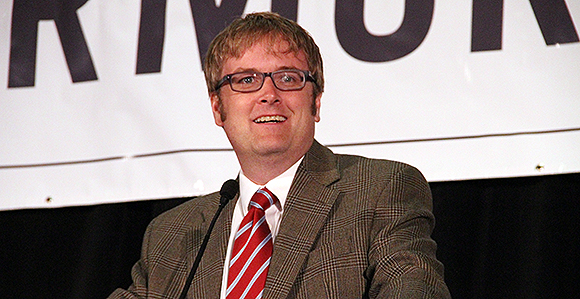Conference Gives Sneak Peek into Council of Fifty Minutes, a Newly Released Nauvoo-Era Document
Contributed By R. Scott Lloyd, Church News staff writer

Matthew J. Grow gives a presentation at the FairMormon Conference about the Council of Fifty Minutes, long kept away from public access but soon to be published as part of the Joseph Smith Papers.
Article Highlights
- The minutes provide a way of studying how Church members can make decisions according to inspiration and the council process.
Related Links
PROVO, UTAH
The Nauvoo Council of Fifty Minutes, long shrouded in mystery because they were not accessible to the public for research, will be published next month as the latest volume in the Joseph Smith Papers Project. A speaker at the FairMormon Conference on August 4 gave a sneak peek into the new book.
“Because the minutes have never been open to research, the Council of Fifty has been the subject of tremendous speculation over the years,” said Matthew J. Grow, director of publications with the Church History Department and a general editor of the Joseph Smith Papers.
“The views expressed in the council’s minutes represent the thinking of Church leaders in the mid-1840s, a particularly turbulent time in both Mormon and American history, not what the Church teaches today about topics such as theocracy,” he reflected. “Today, the Church makes every effort to be politically neutral, even during the past presidential election featuring a Church member. The contents of these minutes remind us of another era in which the Church was decidedly not politically neutral.”
Brother Grow posed and answered a number of questions regarding the minutes:
Where did they come from?
William Clayton, Joseph Smith’s clerk appointed in 1842, kept minutes on loose sheets of paper, later copied into three small, bound volumes. They were kept secret because council members believed knowledge of the discussions would increase the already widespread but mistaken belief that Latter-day Saints opposed key elements of American democracy.
They were taken to Utah during the Nauvoo exodus of 1846 and used in preparation of the multivolume manuscript history of the Church that Joseph Smith had begun. But they continued to be guarded, and at some point they became part of the collection of the First Presidency, where they remained through the 20th and early 21st centuries.
In 2013, the First Presidency authorized publication of the minutes as part of the Joseph Smith Papers.
When and why was the council formed?
The council was formally organized March 11, 1844. A proposal to establish a settlement in Texas for the Church led to discussions about creating a theocracy, or “theo-democracy,” a government in which Church leaders would have political as well as ecclesiastical power.
Persecutions the Latter-day Saints had experienced in Missouri in the 1830s were perhaps the primary reason Church leaders were so enthusiastic about the above matters. A government blending the best elements of theocracy and democracy theoretically would protect the rights of minorities, allow for dissent and free discussion, involve both Latter-day Saints and others, and increase righteousness in preparation for Christ’s Second Coming.
How did the council relate to the Church?
The council was not an ecclesiastical body. It was a temporal or political body created to protect the Church and provide it space to flourish.
What did the council accomplish during the Nauvoo era?
The council helped manage Joseph Smith’s campaign for the United States presidency. It provided a forum for practical decisions about Nauvoo matters, including construction of the temple and how to protect and govern the city after Illinois repealed the Nauvoo municipal charter in early 1845. And it played a major role in exploring possible settlement sites and planning the Church’s migration to the West.
What can Latter-day Saints today learn from the Council of Fifty Minutes?
Brother Grow said the minutes provide a way of studying how Church members can make decisions according to inspiration and the council process. Decisions had to be unanimous, and much of the business was delegated to committees of a few members who studied assigned matters and returned with recommendations.
FairMormon Conference
The annual FairMormon Conference convened at the Utah Valley Convention Center in Provo August 4–5 with addresses from 15 presenters.
FairMormon is an organization of volunteers dedicated to “standing as a witness of Christ and His restored Church,” according to its mission statement, though the group is not formally affiliated with the Church.
“Our mission is to address the charges leveled at the doctrines, practices, and leaders of [the Church] with documented responses that are written in an easily understandable style.
“FairMormon will use current scholarship, scripture, Church doctrine, historical literature, and sound logic in constructing faithful, well-reasoned answers.”
